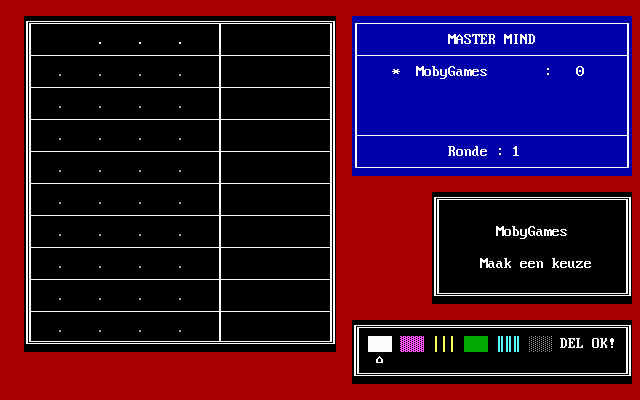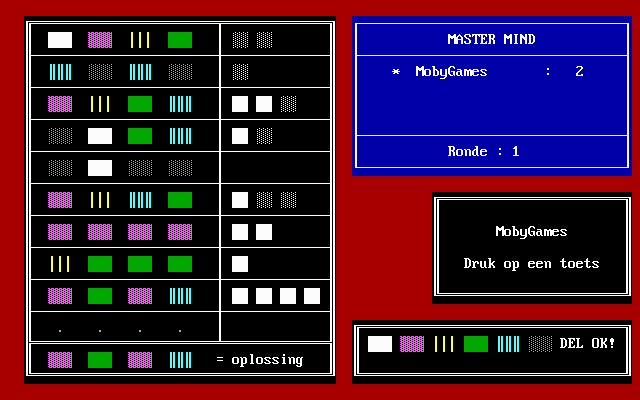Retro Replay Review
Gameplay
Master Mind challenges players to deduce a hidden sequence of four tokens within ten attempts, making every guess a thrilling exercise in logic and pattern recognition. After each attempt, the game provides two pieces of feedback: how many tokens are exactly correct in both color and position, and how many tokens are correct in color but placed incorrectly. This simple yet profound mechanic encourages players to refine their strategy with each guess, turning every round into a captivating puzzle.
(HEY YOU!! We hope you enjoy! We try not to run ads. So basically, this is a very expensive hobby running this site. Please consider joining us for updates, forums, and more. Network w/ us to make some cash or friends while retro gaming, and you can win some free retro games for posting. Okay, carry on 👍)
The heart of Master Mind’s gameplay lies in its elegant feedback loop. Players begin by forming an initial hypothesis—often a spread of different colors—to gather as much information as possible. As the game progresses, the feedback pins guide the player to eliminate impossible combinations and zero in on the correct code, fostering a rewarding “aha” moment when the solution finally clicks.
Difficulty scales naturally through the limited number of tries. With only ten chances to crack the code, every guess feels meaningful; wasted attempts heighten the tension and reward careful deduction. This constraint also boosts replayability, as each session becomes a chance to better your success rate or challenge yourself by setting internal time or attempt records.
Beyond solo play, Master Mind offers asynchronous multiplayer modes where you can trade roles with friends—one sets the code while the other tries to break it. This head-to-head twist emphasizes mind games and bluffing, elevating the experience from a solitary puzzle to a competitive duel of wits.
Graphics
Visually, Master Mind embraces a clean, minimalist design that keeps the focus squarely on game mechanics. The board is presented against a neutral backdrop, allowing the color-coded tokens to stand out clearly. Each token’s hue is vibrant and distinct, ensuring players can quickly identify patterns without visual confusion.
The user interface is intuitive and responsive. Drag-and-drop mechanics for placing tokens are smooth, and feedback pegs appear instantly after each guess. A subtle animation plays when pins reveal correct placements, adding just enough flair to feel satisfying without slowing down gameplay.
Despite its simplicity, the visual presentation feels polished. Menus are uncluttered, and colorblind-friendly options allow players with differing vision capabilities to customize the token shapes or add distinguishing patterns. This accessibility feature broadens the game’s appeal, making it welcoming for all puzzle enthusiasts.
On higher-end platforms, slight particle effects accent the feedback pegs when you crack the code, giving a modest sense of achievement. While there are no elaborate cutscenes or 3D environments, the clarity and responsiveness of the visuals perfectly complement the cerebral nature of the game.
Story
Master Mind foregoes a traditional narrative in favor of a pure puzzle experience. Rather than weaving an elaborate tale, it invites players to imagine the role of cryptographer, detective, or codebreaker operating in a high-stakes scenario. The absence of scripted characters or plot twists means the real story unfolds in your mind as you strategize each guess.
Some players may miss a structured storyline, but the game compensates with emergent narratives: “Will I outsmart the code today?” or “Can I outguess my friend?” These personal stakes and self-imposed challenges create a unique, player-driven story each session. Every victory feels like a triumph of intellect.
The minimalist approach to story also ensures that nothing distracts from the core gameplay loop. Without cutscenes or dialogue interruptions, players dive straight into puzzle-solving. This design choice respects the audience’s desire for uninterrupted concentration, offering a streamlined experience that remains engaging over multiple playthroughs.
For those seeking deeper lore, the game includes a challenge mode themed around historical figures known for codebreaking, like a tribute to Alan Turing or the Enigma machines of World War II. While these vignettes are brief, they provide context and homage to the real-world origins of Master Mind’s fundamental puzzle concept.
Overall Experience
Master Mind delivers a timeless puzzle formula wrapped in a modern, user-friendly package. Its blend of straightforward rules and deep strategic potential makes it accessible to newcomers while still offering layers of complexity for seasoned players. Whether you have five minutes or fifty, each session is rewarding and mentally invigorating.
The game’s pacing strikes a fine balance between tension and satisfaction. The ten-attempt limit keeps rounds brisk, yet it’s lenient enough to allow experimentation. Players often find themselves returning for “just one more try,” determined to beat their personal best or improve turn efficiency.
With configurable difficulty settings, colorblind options, and both solo and asynchronous multiplayer modes, Master Mind caters to a wide audience. Puzzle lovers looking for a quick brain-teaser and competitive minds seeking head-to-head mind games will both find something to love.
In summary, Master Mind stands out as a thoughtfully designed logic puzzle experience that looks simple on the surface but offers rich strategic depth. If you’re in the market for a game that tests your deductive reasoning and keeps you coming back for more, Master Mind is an excellent choice.
 Retro Replay Retro Replay gaming reviews, news, emulation, geek stuff and more!
Retro Replay Retro Replay gaming reviews, news, emulation, geek stuff and more!






Reviews
There are no reviews yet.